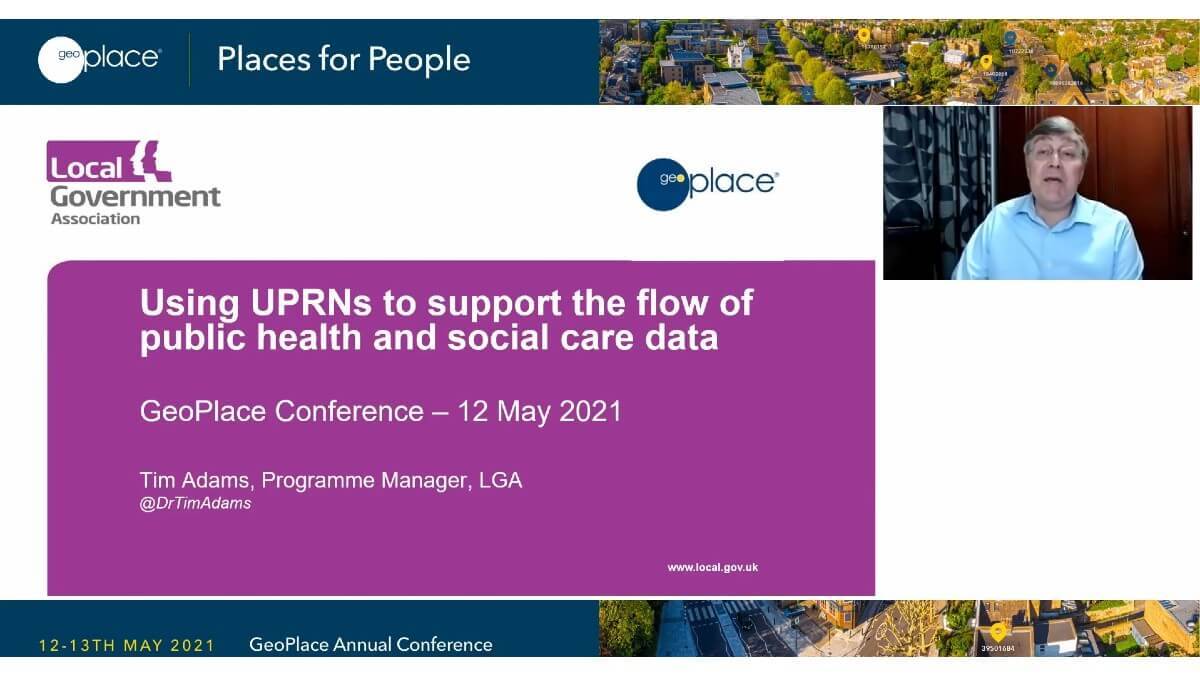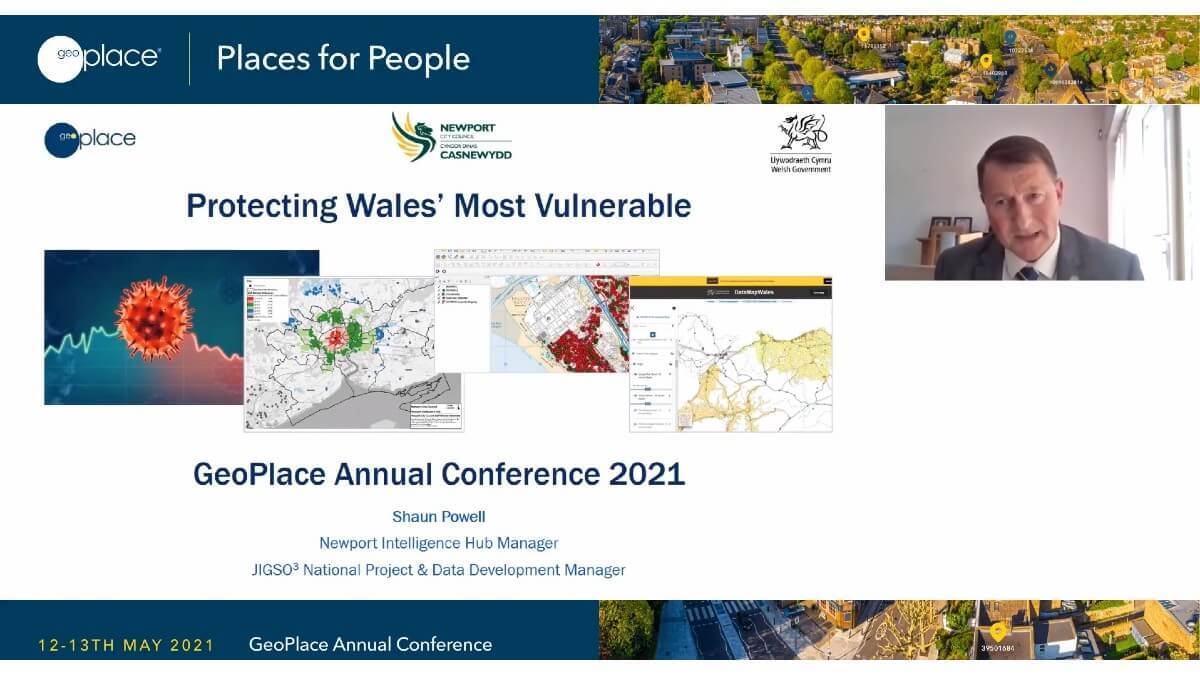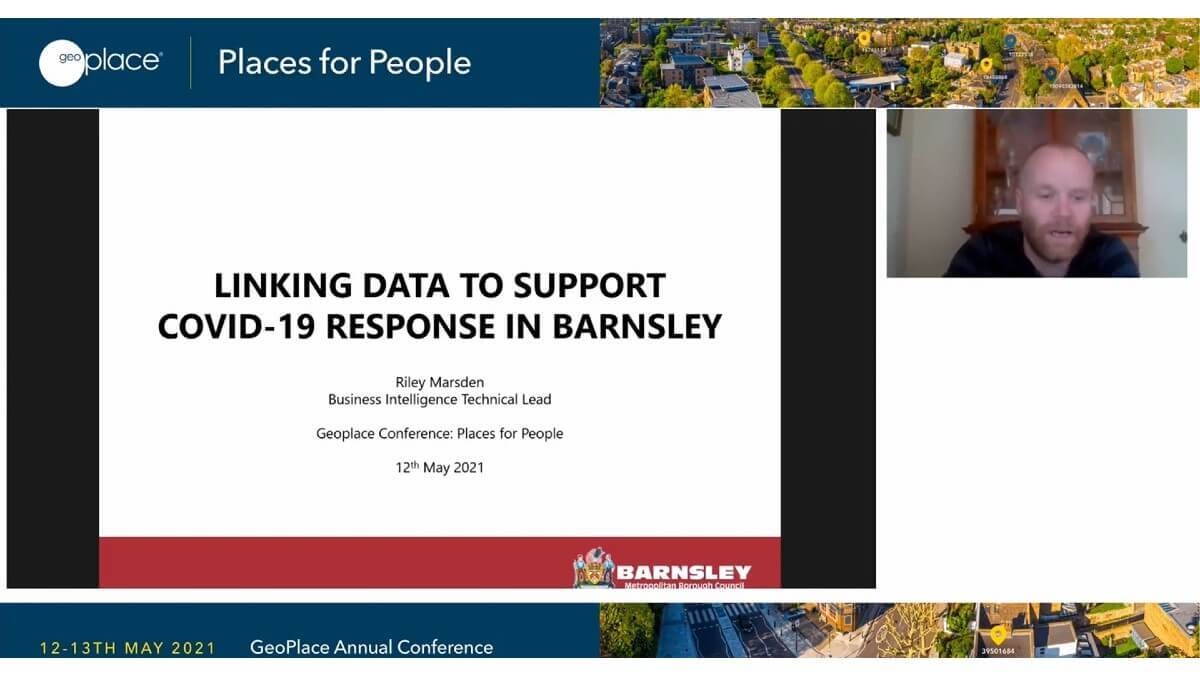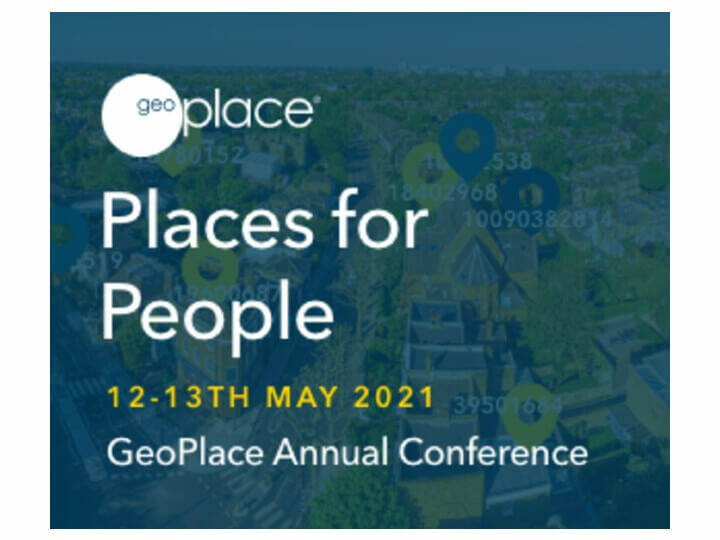Day 1, Session 3 - Looked at Health and Social Care, and how location information can enable segmentation and targeting of support to those that need it most.
Speakers included:
- Tim Adams, Programme Manager, Local Government Association
- Shaun Powell, Newport Intelligence Hub Manager
- Riley Marsden, Business intelligence Technical Solutions Lead, Barnsley Metropolitan Borough Council

Listen to the presentations here.
As the Programme Manager for the Local Government Association (LGA), Tim Adams and his team were charged with looking at huge amounts of data being collected by local authorities, and how it was being used during the pandemic and the lockdowns of 2020. The project’s aspiration was to understand how location in particular could be life-changing, and life-saving in many instances, in the provision of support and shielding for the vulnerable in society.
Councils had to find out where citizens were living – this was a ‘ground-up’ exercise, there was no protocol to follow – and to help the vulnerable in particular, to access the support services they needed. The challenges were obvious and immediate: data protection, data availability, data integration … but the solution to these problems lay overtly in having access to location data, in the form of Unique Property Reference Numbers (UPRNs). As Tim pointed out, the UK probably has one of the best geographic frameworks for society, anywhere in the world. Like a tripod – three simple aspects of location become immensely powerful: postcode addresses, geographic co-ordinates (an X and Y) to refine those postcodes, and the 12-digit UPRN.
Seven authorities took part in this project. Barnsley Metropolitan Borough Council; Worcestershire County Council; Sedgemoor in Somerset; Sheffield City Council; Durham County Council; Mole Valley District Council; and Leeds City Council. Focussing on these authorities gave a good cross-section and geographic spread, and a wide range of reactions and approaches to the problems experienced due to the pandemic. Councils need to access the magnitude of the task in their particular area; to understand how and where to move resources so that the vulnerable, in particular, would be supported.
Data was wide-ranging. External datasets were coming in from all kinds of sources: vaccination and ‘test and trace’ information coming from Public Health England, for example, the shielding lists from MHCLG; clinically vulnerable lists, coming from the NHS. These all needed to be combined with authorities’ internal datasets, such as electoral registration records and council tax records – and these internal datasets were an invaluable source of insight, when it came to using that vast pool of data to provide the support that was needed. Assisted refuse collection, for example, was an indicator of a household that might need additional health support in a crisis.
However, in the seven case studies, councils were able to add UPRNs to datasets as necessary, start matching names and addresses, and build up a much more useful interpretation of where people lived, and where they needed support. This addition of the UPRN meant that various departments were then able to use different facets of the datasets, to triage people’s needs quickly, and to contact the right households to offer the right kind of support. Gap analysis became easier.
UPRNs were critical, essential in fact, for connecting these disparate datasets. The central lists issued by Government did include UPRNs in later releases, and those councils who did use the UPRNs widely excelled in providing Covid support. Barriers included awareness and suspicion around data integrity, but overall, the projects’ results were pivotal. Interestingly, the project surfaced a number of future challenges – such as departments within authorities not being aware that Custodians existed, nor that location data would be so useful to them. However, one of the outcomes was the development of an online app that will connect the local authority staff with Custodians directly – providing contact details via a very simple online app.
In short, those councils that used location data as the key to integrate and analysis data, excelled in their pandemic responses. This work has provided momentum for many other projects. Barnsley are setting up a cross-system data for hospital admissions; Durham is improving its school census initiative; Mole Valley have created a new GIS analyst role; Sheffield is running workshops for its staff on potential for location data; and Sedgemoor is working on the Scalable Approach to Vulnerability vie Interoperability project – developing standards and protocols for collection and connecting data.

Shaun Powell, the Intelligence Hub Manager for Newport City Council in Wales, followed on from Tim with some more detailed insights about the practical application of location data in responding to the pandemic. As he stated, there has been a lot of publicity for our nation’s ‘superheroes’, our emergency services and keyworkers, and our stalwart colleagues in the NHS. However, not all superheroes wear uniforms, and some individuals have been working tirelessly behind the scenes to help the most vulnerability in society.
When the pandemic took hold, the mandate for shielding came into place – putting the emphasis on systems that could support the most vulnerable in society, who were staying at home, wherever possible. That meant addressing was in the spotlight. Twenty years ago, many people held different opinions about what comprised a good address but, today, we now have a definitive, golden data source. In fact, as address experts, we don’t need to be convinced about the value of addressing. That said, the value of that address is what we derive from it. We can all use a mail merge or a computer system to create a letter or a report that has an address on it, but Covid did expose the fact that, despite huge progress in the Gazetteers themselves, central Government’s existing data structure wouldn’t deliver what was needed.
So, to provide the most help to our frontline critical support, it was necessary to take core data and enrich it with additional information. NHS Wales Informatics Service issued a ‘Cohort 1 List’ – 19,037 records in total. When that data was enriched with the right information, visualisation made it easy to see which areas needed resources – where to mobilize and how to provide support. At speed, the team accurately disaggregated and disseminated 144,000 Shielded Patients List records across 22 Welsh LAs, extending over 30 issued cohort list. That involve integrating those 144,000 records with the data held in local authorities’ social care systems, and at the same time, using that information to underpin the development of the National Food Parcel Scheme. This work also involved sharing data, securely, with 8 major supermarkets, and enabling major water and utility companies to use it, and in support of emergency supply response. Finally, the data was shared to ensure a daily deceased notification list was up to date – essential, to mitigate the unnecessary anxiety experienced by bereaved families.
Knowing who needed care, and where, was essential. The work enabled the Newport team to build dashboards that supported strategic and operational decisions within the authority; it helped other departments to work with volunteer groups, and to influence dynamic situational awareness – to work out whether or not a householder was receiving volunteer help, under safeguard, being contacted, or receiving food parcels.
Most importantly perhaps, once the UPRN had been included in the amalgamated datasets, the local resilience forums could use that information to make rapid, effective decisions in vulnerable people’s best interests. The opportunities discovered included improving data management and quality; developing sustainable data integration, and dynamic master data solutions that are secure and trusted. Shaun said: “What we know, is that we’ve just been through an incredible experience and that we are privileged to be working alongside unseen superheroes who’ve been doing life-changing, life-saving work.”

Riley Marsden – the Business intelligence Technical Solutions Lead for Barnsley Metropolitan Borough Council – echoed Shaun’s sentiments. Barnsley’s experience was quite similar. In his presentation, Riley focused on one element in particular, the Test and Trace / Self-Isolation Support provision that was so necessary as the pandemic took hold. He explained that, from a data perspective, the team’s response to Covid-19 wasn’t something that happened over night – Barnsley’s team already had a strategic and operational plan for processing data routinely, which was formative in delivering products that could support vulnerable people. Instead of building reports directly from inputs, the team processes it first, enabling a wide variety of reports and views of the same information – master data – to be created very efficiently, and with the confidence that the original data is single-source.
Specifically on Test and Trace, the service was established in May 2020 and began releasing data quickly through Covid Situational Explorer. But it was built to be an evolving service, and is now an exceptionally rich data source for Britain; full of case data, contact tracing, common exposure locations, coin coincidences, vaccine uptake, genomic sequencing data and more.
Riley explained that the core data is downloaded every day, ensuring currency, to help support the build of products and services that could service every team’s needs. Not very much of the data downloaded had UPRNs in it, so everything needed to have the UPRN added. Every day, as a semi-automated process, 10 datasets were processed through 15 sequential ETL (‘extract, transform, and load’) routines each day – much more of this work can be fully automated if UPRNs were added at source.
However, the output from this work is about 30 database tables – everything from test cases and contacts to composite testing accuracy, all from the same single source. Essentially, this means the team created ‘the’ source of data that was most usable for stakeholders, organised the way they need it to answer queries and inform their work. The dashboard now includes slices of data that show, for example, Welfare Calls (anonymised data), which are divided by neighbourhood and show the activity of outbound call teams, statuses, clusters in the same household – crucial for minimising the number of calls to one residence.
Riley provided a further example: the authority’s ‘Positive Test Results’ page within the dashboard draws from the single source of verified data – matched with a UPRN – and is also linked to internal, local data such as the number of people in the household and details about vulnerability or depravation.
Since September 2020, the team was able to make proactive contact with 16,480 positive Covid cases, to establish their support needs. The UPRN has been key to this work, identifying household clusters of positive cases; using local contact details to deliver service excellence; and managing the outbreak generally. What this pandemic has shown, however, is that central Government agencies need help to understand local needs, and aren’t geared up to deliver high-quality data services at pace – the UPRN could and should be adopted much higher in the chain of data creation.
A key lesson is that Barnsley’s success isn’t just about using technology to help support vulnerable people in the area, it’s also been about having the right people to build data, use it, improve it, and be agile and ready for change.


